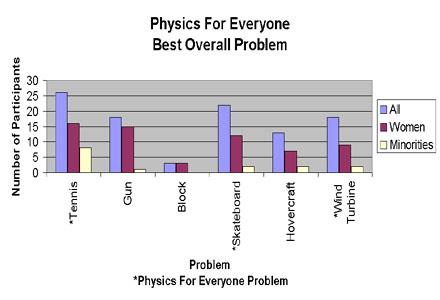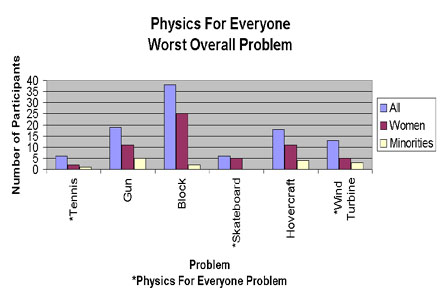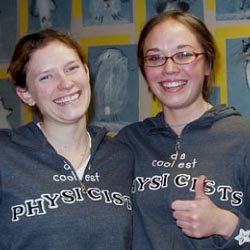|
Home
Project Evaluation
|
|||||||
Evaluation of Physics For Everyone Problems
Shannon Dorato, Jes Rivas, Phillip Cervantes
•
•
1) Charleton Heston has a rifle that shoots with a velocity of 1500 feet per second. He wants to shoot a small target 150 ft away. How high above the target must he aim the gun so that its bullet will hit the target?
*2) Wimbledon champs Venus and Serena Williams are playing a friendly tennis match. Holding her racket 1.5 meters above the ground, Serena returns an incoming ball at an angle that is 5 o below the horizontal, and a speed of 10 m/s. If Venus runs to the ball and returns it just before it hits the ground, how much time did she have to get to the ball? _________________________________________________ SECTION 2 *3) You are out skateboarding when you approach a hill. You decide you would like to try and coast up the hill by getting all your momentum on level ground. Placing your board just before the foot of the hill, you back up to get a running start. You are sprinting at 5.5 m/s as you jump onto the board. If the board is 4.5 kg, what is the speed of you and your board just after you jump? 4) A block of mass m1=100 kg is at rest on a very long frictionless table, one end of which is terminated in a wall. Another block of mass, m2, is placed between the first block and the wall and set in motion to the left with constant speed v2. Assuming that all collision are completely elastic, find the value of m2 for which both blocks move with the same velocity after m2 has collided once with m1 and once with the wall. Assume the wall has infinite mass effectively. ______________________________________________ SECTION 3
6) The potential energy of Gene Roddenberry’s all terrain two-person hovercraft is named U(x,y). A) At rest what are the force vectors, x and y? B) When the hovercraft is going 50 mph due East, what are the force vectors x and y? _______________________________________________ *Physics For Everyone Problem
Physics for Everyone There were three null hypotheses for this survey. They were that people, women, and minorities will not prefer PFE problems to the problems that do not follow the ten PFE guidelines. This is suggesting that people will not prefer one type of problem to another. To test the validity of the PFE guidelines a Gaussian approximation of binomial distribution for the null hypotheses was used to analyze the data. Of all the students surveyed there is a 0.0687% probability that the null hypothesis is true because 66 out of 100 participants chose a Physics For Everyone problem as the best problem in the survey. This is highly significant because it is better than 1%. In addition, because 75% of participants chose a non-PFE problem as the worst problem of the survey, there is a 1.16x10^-27% probability that the null hypothesis is true, again highly significant. Of the women surveyed there is a 6.4% probability that the null hypothesis is true because 37 out of 62 female participants chose a Physics For Everyone problem as the best problem in the survey. This is significant because it is not much greater than 5%. In addition, because 80% of women chose a non-PFE problem as the worst problem of the survey, there is a 2.41x10^-3% probability that the null hypothesis is true, this is highly significant as it is better than 1%. Of the minorities surveyed there is a 0.044% probability that the null hypothesis is true because 12 out of 15 minority participants chose a Physics For Everyone problem as the best problem in the survey. This is highly significant because it is better than 1%. In addition, because 73% of minorities chose a non-PFE problem as the worst problem of the survey, there is a 0.043% probability that the null hypothesis is true, this is also highly significant. The following graphs summarize our results from all the participants, the women, and the minorities as to which problem they chose as the best and the worst.
Our analysis demonstrates that the majority of the participants prefer physics problems that follow the ten Physics for Everyone guidelines. Women and minority students in particular preferred PFE problems. This suggests that PFE problems might be useful in attracting women and minorities to physics.
|
|||||||
Posted on 8/1/05 © 2000-2005 Physics For Everyone. All Rights Reserved. |
|||||||
 *5) Wind turbines, the new phase of what you remember as windmills, are one of the only zero-emission sources of electricity in the world. Doing some pleasure reading, you find out that a practical wind turbine can convert about 40% of the wind’s KE into electric energy! A) How much KE is there is the section of wind that passes through a turbine with a rotor diameter of 75 feet in 1 minute? B) What is the physical model of this energy and how much electric energy does it contain?
*5) Wind turbines, the new phase of what you remember as windmills, are one of the only zero-emission sources of electricity in the world. Doing some pleasure reading, you find out that a practical wind turbine can convert about 40% of the wind’s KE into electric energy! A) How much KE is there is the section of wind that passes through a turbine with a rotor diameter of 75 feet in 1 minute? B) What is the physical model of this energy and how much electric energy does it contain? 

